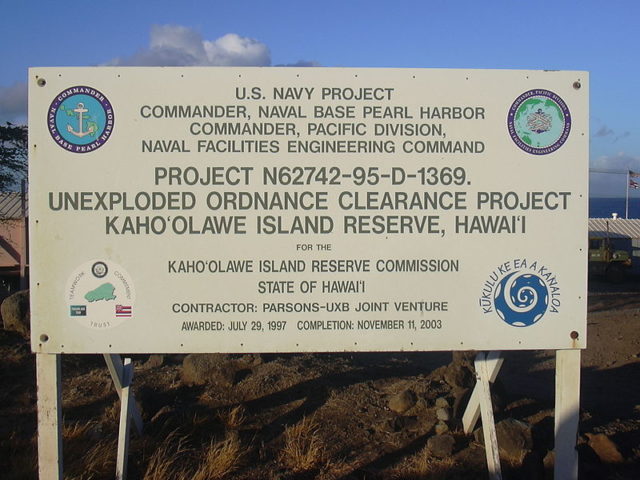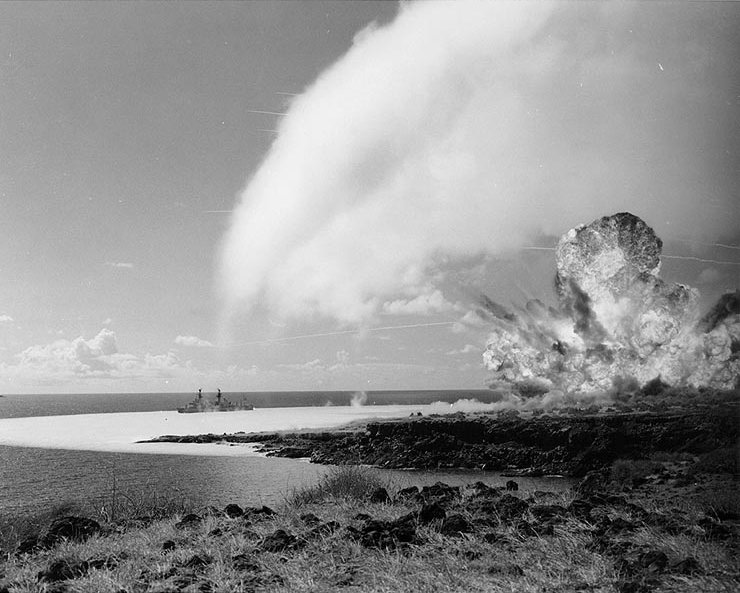There is a deserted island just six miles from the famous, scenic beaches of Maui that, despite its appearance, has a rich history. It also has a huge problem.
It is called Kahoolawe Island, and researchers believe that the first Hawaiians arrived on the island as early as 400 AD. That history is found in the nearly 3,000 archeological sites. The more recent history is found in the form of shrapnel and unexploded bombs that litter the small island.
Starting in the Second World War, the U.S. Navy used the barren island as a bombing range. It later joined with the state and spent millions on cleanup, but the job wasn’t finished. This means that there are live grenades and bombs that remain across a quarter of the 45-square-mile island. Some of these bombs weigh more than 2,000 pounds. The live-fire training and testing at Kahoolawe ended in 1990, and the Navy, in charge of the whole operation, was responsible for cleanup.
The problem is that the funding that is being used to continue cleanup today is now in jeopardy. The agency tasked with restoring Kahoolawe says that it is on its own, financially, next year. Lawmakers have passed a measure that will give $450,000 for the upcoming year, but in 2017, there will be no funding. One of the requirements is that the agency writes up a plan to become self-sufficient.
The proposal has been sent to Gov. David Ige, who hasn’t said whether he will sign it into law. Unfortunately, back in 2013, a financial audit criticized the Kahoolawe commission for lacking a comprehensive cleanup plan and measures to gauge if objectives are being met.
The agency, called Kahoolawe Island Commission, as well as community advocates, are now trying to figure out how to fund the rest of the cleanup required in order to bring back native wildlife and to be able to use the island as a Native Hawaiian educational center.
It’s no small task. Restoring and then replanting the entire island will cost billions of dollars, despite the $400 million already spent by the commission and the Navy since 1994. A federal trust fund containing $44 million was also depleted since 2004 in the restoration effort. Not only that, but the cleanup is likely to take decades.
“It speaks volumes to the amount of bombing Kahoolawe sustained that so much work still needs to be done to complete this effort,” U.S. Sen. Mazie Hirono said. She added that she will work to help find solutions to finish the cleanup at the culturally significant site. Luckily, there is a ban on the site from being used for commercial purposes.
As previously mentioned, Kahoolawe Island has thousands of archeological sites. Despite the Navy testing out explosives for fifty years, many of these archeological sites, including sites that were once fishing shrines, managed to survive, according to Michael Nahoopii.

Nahoopii is the executive director of the Kahoolawe Island Reserve Commission. On clear days, the islands of Maui, Lanai, and Molokai are visible from the shores of Kahoolawe. This has lead researchers to suggest that Hawaiians used them as a navigational center for voyages and possibly even a site for cultural ceremonies to take place.
“You walk across this line, and it is night and day. One side of the line is very clean. There’s no scrap metal. There’s nothing on the ground,” Nahoopii said. “You walk across this line, and there’s bombs sticking out of the ground. There are pieces of razor-sharp metal.”
As for becoming financially self-sufficient, the Commission is considering various ideas. One outlines a plan to have the island depend completely on renewable energy, while others suggest charging tuition for the educational programs that the commission offers.
The responses to being cut off federal funding are understandable. Josh Kaakua, a commissioner, and member of the Protect Kahoolawe Ohana, said the state should help fund Kahoolawe’s restoration. This makes sense because the state did take responsibility of the island after the Navy ended the federal cleanup. Nahoopii believes that the Navy has a responsibility to finish restoring the island since it was the one to use it for their tests. He pointed out that when the federal government took over Kahoolawe in the 1950s, it agreed to return the land to pre-WWII condition, or “suitable habitation.”
It should be noted that when asked about Kahoolawe Island, the director of public affairs for Navy Region Hawaii, Agnes Tauyan, claimed that the Navy completed what was required by the federal government—she also wasn’t aware of any requests to return to Kahoolawe for cleanup help.
In the Pacific, there are 100 other locations that fall under the Formerly Used Defense Sites Program that is overseen by the U.S. Army Corps of Engineers. Kahoolawe Island is not one of them. It would have been helpful; this program has been cleaning up property once used by the military pre-1986. Those sites, however, do not require nearly as much work as Kahoolawe does explained Joseph Bonfiglio, spokesman for the Honolulu Army Corps of Engineers.
Problems connected with the military aside, the island has other issues. For years, before military use, cattle and goat ranches were located on the island, and the native flora and fauna suffered for it. Without plants, severe erosion has occurred. Fresh water sources are scarce, which contributed to the destruction of the local flora.
“I think people only care about what’s in their backyard, so often I think Kahoolawe gets put to the side,” Kaakua said. “Kahoolawe is a treasure. It’s a resource. But we’re losing it. We’re slipping. Nobody is paying attention.”
For now, the cleanup is continuing, thanks in large part to the volunteers who come and carefully pick their way through razor-sharp debris, bombs, and gold-colored grenades.
